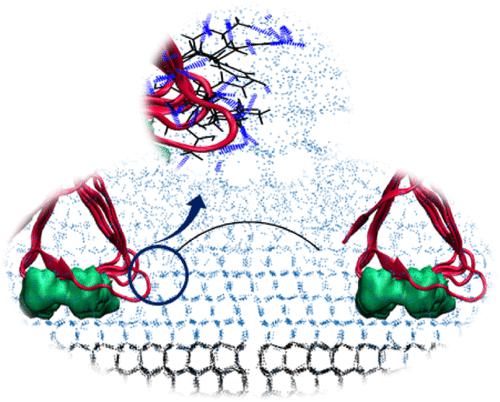Our official English website, www.x-mol.net, welcomes your
feedback! (Note: you will need to create a separate account there.)
Molecular Factors of Ice Growth Inhibition for Hyperactive and Globular Antifreeze Proteins: Insights from Molecular Dynamics Simulation
Langmuir ( IF 3.7 ) Pub Date : 2022-11-30 , DOI: 10.1021/acs.langmuir.2c02149
Prasun Pal 1 , Rahul Aich 1 , Sandipan Chakraborty 2 , Biman Jana 1
Langmuir ( IF 3.7 ) Pub Date : 2022-11-30 , DOI: 10.1021/acs.langmuir.2c02149
Prasun Pal 1 , Rahul Aich 1 , Sandipan Chakraborty 2 , Biman Jana 1
Affiliation

|
The molecular mechanism behind the ice growth inhibition by antifreeze proteins (AFPs) is yet to be understood completely. Also, what physical parameters differentiate between the AFP and non-AFP are largely unknown. Thus, to get an atomistic overview of the differential antifreeze activities of different classes of AFPs, we have studied ice growth from different ice surfaces in the presence of a moderately active globular type III AFP and a hyperactive spruce budworm (sbw) AFP. Results are compared with the observations of ice growth simulations in the presence of topologically similar non-AFPs using all-atom molecular dynamics simulations. Simulation data suggest that the ice surface coverage is a critical factor in ice growth inhibition. Due to the presence of an ice binding surface (IBS), AFPs form a high affinity complex with ice, accompanied by a transition of hydration water around the IBS from clathrate-like to ice-like. Several residues around the periphery of the IBS anchor the AFP to the curved ice surface mediated by multiple strong hydrogen bonds, stabilizing the complex immensely. In the high surface coverage regime, the slow unbinding kinetics dominates over the ice growth kinetics and thus facilitates the ice growth inhibition. Due to the non-availability of a proper IBS, non-AFPs form a low-affinity complex with the growing ice surface. As a result, the non-AFPs are continuously repelled by the surface. If the concentration of AFPs is low, then the effective surface coverage is reduced significantly. In this low surface coverage regime, AFPs can also behave like impurities and are engulfed by the growing ice crystal.
中文翻译:

过度活跃和球状抗冻蛋白的冰生长抑制的分子因素:来自分子动力学模拟的见解
抗冻蛋白 (AFP) 抑制冰生长的分子机制尚待完全了解。此外,区分 AFP 和非 AFP 的物理参数在很大程度上是未知的。因此,为了对不同类别的 AFP 的不同抗冻活性进行原子学概述,我们研究了在存在中等活性的球状 III 型 AFP 和过度活跃的云杉芽虫 (sbw) AFP 的情况下,不同冰面的冰生长。将结果与使用全原子分子动力学模拟在存在拓扑相似的非 AFP 的情况下冰生长模拟的观察结果进行比较。模拟数据表明,冰面覆盖是抑制冰生长的关键因素。由于冰结合表面 (IBS) 的存在,AFP 与冰形成高亲和力复合物,伴随着 IBS 周围的水合水从包合物状转变为冰状。IBS 周围的几个残基将 AFP 锚定到由多个强氢键介导的弯曲冰表面,极大地稳定了复合物。在高表面覆盖范围内,缓慢的解结合动力学在冰生长动力学中占主导地位,从而促进了冰生长抑制。由于无法获得适当的 IBS,非 AFP 会与不断增长的冰面形成低亲和力复合体。结果,非 AFP 不断被表面排斥。如果 AFP 浓度低,则有效表面覆盖率会显着降低。在这种低表面覆盖范围内,AFP 也可能表现得像杂质,并被不断增长的冰晶吞没。
更新日期:2022-11-30
中文翻译:

过度活跃和球状抗冻蛋白的冰生长抑制的分子因素:来自分子动力学模拟的见解
抗冻蛋白 (AFP) 抑制冰生长的分子机制尚待完全了解。此外,区分 AFP 和非 AFP 的物理参数在很大程度上是未知的。因此,为了对不同类别的 AFP 的不同抗冻活性进行原子学概述,我们研究了在存在中等活性的球状 III 型 AFP 和过度活跃的云杉芽虫 (sbw) AFP 的情况下,不同冰面的冰生长。将结果与使用全原子分子动力学模拟在存在拓扑相似的非 AFP 的情况下冰生长模拟的观察结果进行比较。模拟数据表明,冰面覆盖是抑制冰生长的关键因素。由于冰结合表面 (IBS) 的存在,AFP 与冰形成高亲和力复合物,伴随着 IBS 周围的水合水从包合物状转变为冰状。IBS 周围的几个残基将 AFP 锚定到由多个强氢键介导的弯曲冰表面,极大地稳定了复合物。在高表面覆盖范围内,缓慢的解结合动力学在冰生长动力学中占主导地位,从而促进了冰生长抑制。由于无法获得适当的 IBS,非 AFP 会与不断增长的冰面形成低亲和力复合体。结果,非 AFP 不断被表面排斥。如果 AFP 浓度低,则有效表面覆盖率会显着降低。在这种低表面覆盖范围内,AFP 也可能表现得像杂质,并被不断增长的冰晶吞没。

































 京公网安备 11010802027423号
京公网安备 11010802027423号